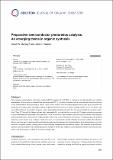Files in this item
Preparative semiconductor photoredox catalysis : an emerging theme in organic synthesis
Item metadata
| dc.contributor.author | Manley, David W. | |
| dc.contributor.author | Walton, John C. | |
| dc.date.accessioned | 2015-10-01T14:40:01Z | |
| dc.date.available | 2015-10-01T14:40:01Z | |
| dc.date.issued | 2015-09-09 | |
| dc.identifier | 220729360 | |
| dc.identifier | 4804a590-fb72-467c-a40b-3a05c85e676d | |
| dc.identifier | 000360959600001 | |
| dc.identifier | 84962173687 | |
| dc.identifier | 000360959600001 | |
| dc.identifier.citation | Manley , D W & Walton , J C 2015 , ' Preparative semiconductor photoredox catalysis : an emerging theme in organic synthesis ' , Beilstein Journal of Organic Chemistry , vol. 11 , pp. 1570-1582 . https://doi.org/10.3762/bjoc.11.173 | en |
| dc.identifier.issn | 1860-5397 | |
| dc.identifier.uri | https://hdl.handle.net/10023/7570 | |
| dc.description | Financial support from EPSRC (Grant EP/I003479/1) and EaStCHEM is gratefully acknowledged. | en |
| dc.description.abstract | Heterogeneous semiconductor photoredox catalysis (SCPC), particularly with TiO2, is evolving to provide radically new synthetic applications. In this review we describe how photoactivated SCPCs can either (i) interact with a precursor that donates an electron to the semiconductor thus generating a radical cation; or (ii) interact with an acceptor precursor that picks up an electron with production of a radical anion. The radical cations of appropriate donors convert to neutral radicals usually by loss of a proton. The most efficient donors for synthetic purposes contain adjacent functional groups such that the neutral radicals are resonance stabilized. Thus, ET from allylic alkenes and enol ethers generated allyl type radicals that reacted with 1,2-diazine or imine co-reactants to yield functionalized hydrazones or benzylanilines. SCPC with tertiary amines enabled electron-deficient alkenes to be alkylated and furoquinolinones to be accessed. Primary amines on their own led to self-reactions involving C–N coupling and, with terminal diamines, cyclic amines were produced. Carboxylic acids were particularly fruitful affording C-centered radicals that alkylated alkenes and took part in tandem addition cyclizations producing chromenopyrroles; decarboxylative homo-dimerizations were also observed. Acceptors initially yielding radical anions included nitroaromatics and aromatic iodides. The latter led to hydrodehalogenations and cyclizations with suitable precursors. Reductive SCPC also enabled electron-deficient alkenes and aromatic aldehydes to be hydrogenated without the need for hydrogen gas. | |
| dc.format.extent | 13 | |
| dc.format.extent | 851953 | |
| dc.language.iso | eng | |
| dc.relation.ispartof | Beilstein Journal of Organic Chemistry | en |
| dc.subject | Carboxylic acids | en |
| dc.subject | Free radicals | en |
| dc.subject | Organic synthesis | en |
| dc.subject | Photocatalysis | en |
| dc.subject | Titania | en |
| dc.subject | Electron-deficient alkenes | en |
| dc.subject | Illuminated titanium-dioxide | en |
| dc.subject | Visible-light photocatalysis | en |
| dc.subject | Phenyl vinyl ether | en |
| dc.subject | Carboxylic-acids | en |
| dc.subject | Tertiary-amines | en |
| dc.subject | Surface photochemistry | en |
| dc.subject | Carbon-Dioxide | en |
| dc.subject | Kolbe reaction | en |
| dc.subject | Heterogeneous photocatalysis | en |
| dc.subject | QD Chemistry | en |
| dc.subject.lcc | QD | en |
| dc.title | Preparative semiconductor photoredox catalysis : an emerging theme in organic synthesis | en |
| dc.type | Journal item | en |
| dc.contributor.sponsor | EPSRC | en |
| dc.contributor.institution | University of St Andrews. School of Chemistry | en |
| dc.contributor.institution | University of St Andrews. EaSTCHEM | en |
| dc.identifier.doi | 10.3762/bjoc.11.173 | |
| dc.description.status | Peer reviewed | en |
| dc.identifier.grantnumber | EP/I003479/1 | en |
This item appears in the following Collection(s)
Items in the St Andrews Research Repository are protected by copyright, with all rights reserved, unless otherwise indicated.

